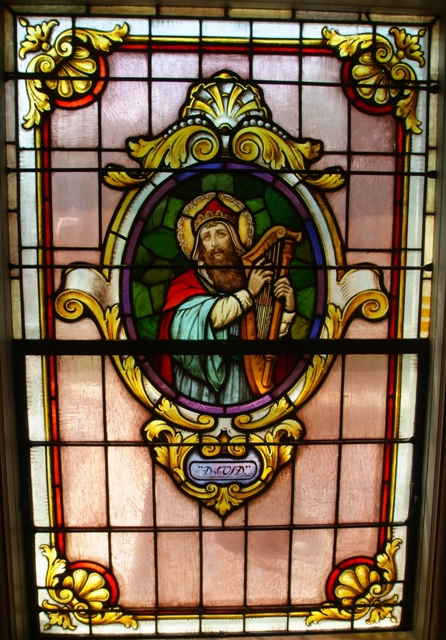
King David
A portrait of King David embellishes the western stairway of the choir loft and is a companion piece to that of St. Cecilia in the eastern stairway.
The life of David is recounted in several books of the Old Testament, primarily in the first two Book of Kings. David first appears in the scriptures as a young shepherd who is “ruddy and beautiful to behold and of a comely face.” While tending his flock, he encounters the prophet Samuel, who anoints him. David’s musical abilities earn him a position at the court of Saul, the first king of Israel, where he soothed the distressed rule with his songs and playing of the harp. Pleased with his musician, Saul made David an armor-bearer. In a war with the Philistines, David slew the giant warrior Goliath, the act for which he is best known. After this victory David returned to court but his behavior drew the wrath of Saul, who on numerous occasions attempted to kill him. Saul’s hatred forced David to flee from the court. After Saul’s death, when David was thirty, he returned to Hebron to claim the crown. The men of Judea warmly welcomed him and he was anointed a second time. David’s reign was long. Through military skill and power he succeeded in making Israel an independent state. A successful ruler and warrior David was not without weakness and on many occasions he fell into sin, his affair with Bathsheba and murder of her husband Uriah being his most publicized lapse into sinfulness. But David was a contrite man, quick to do penance, always ready to praise God. For love of the Lord and out of an eagerness to expiate his sins David composed a number of psalms, today contained in the psalter. David also arranged music for worship in the temple. His songs express prophetic inspiration, thus making him a prophet. In 2 Kings 23: 2, he makes a direct reference to his role as prophet, “The spirit of the Lord hath spoken by me and his word by my tongue.” David is also an ancestor of Jesus, who was born of the house of David. David’s lineage as well as holiness earned him sainthood. The Church honors him as a saint and he is mentioned in the Roman Martyrology, calendar of saints, on December 29.
The portrait of King David at St. John’s captures many aspects of his long life, though primarily his role as a musician and composer of the psalms, an appropriate subject for the setting. The harp he holds aloft and gently plucks represent his status as composer. His crown indicates his kingship. His attire of a white tunic and red cloak, which resemble that of Christ in most of the windows in the Chapel, associates him with his descendent. His halo establishes him as a saint.